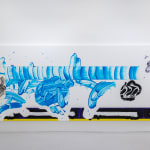David Reed
#659 (Vice and Reflection), 1975/ 1996-2000/ 2007-2011/ 2014-2015/ 2015-2016/ 2016
Acrylic, alkyd and oil on polyester
189.2 x 459.7 cm
74 1/2 x 181 inches
74 1/2 x 181 inches
Copyright the artist | Courtesy of Häusler Contemporary Zurich
Photo: Dirk Tacke
Weitere Abbildungen
-
(View a larger image of thumbnail 1
)

-
(View a larger image of thumbnail 2
)

-
(View a larger image of thumbnail 3
)

-
(View a larger image of thumbnail 4
)

-
(View a larger image of thumbnail 5
)

-
(View a larger image of thumbnail 6
)

-
(View a larger image of thumbnail 7
)

-
(View a larger image of thumbnail 8
)

-
(View a larger image of thumbnail 9
)

-
(View a larger image of thumbnail 10
)

Das großformatige Gemälde #659 (Vice and Reflection) ist stark von der Bewegung des Films inspiriert und thematisiert die Wechselwirkung von Zeit, Bewegung und Wahrnehmung, indem Reed filmische Kompositionsstrategien auf die...
Das großformatige Gemälde #659 (Vice and Reflection) ist stark von der Bewegung des Films inspiriert und thematisiert die Wechselwirkung von Zeit, Bewegung und Wahrnehmung, indem Reed filmische Kompositionsstrategien auf die Leinwand überträgt. Er verwandelt in seiner Malerei die expressive Geste des Farbauftrags in eine künstlich kontrollierte Darstellung des Pinselstrichs, die sich über zahlreiche Schichten von Überlagerungen und Abschleifungen von Farbe aufbaut. Dabei lotet der Künstler die Grenzen zwischen malerischer Geste und medialer Ästhetik aus die hier von der visuellen Sprache der 1980er Jahre, insbesondere von der TV-Serie Miami Vice, geprägt ist. Neonleuchtende Blau- und Gelbtöne erinnern an das Licht und die nächtliche Atmosphäre Miamis, wie sie in der ikonischen Serie zum Leben erweckt wurde. Reeds Einsatz von durchscheinenden Flächen und intensiven Farben evoziert das kühle, stilisierte Ambiente, das typisch für das filmische Erleben ist. Dabei scheinen seine „Brushstroke“-Elemente förmlich aus dem Bild zu schweben, als würde die Malerei in den Raum der Projektion übergehen. Reed inszeniert den Pinselstrich als Bildobjekt und löst sich damit von der unmittelbaren Ausdrucksgeste des abstrakten Expressionismus. Seit den 1970ern schafft Reed Werke, die sowohl das Malen selbst als auch die Wahrnehmung von Oberfläche und Tiefe thematisieren.
The large-format painting #659 (Vice and Reflection) is heavily inspired by the movement of film, exploring the interplay of time, movement, and perception as Reed transfers cinematic composition strategies onto the canvas. In his painting, he transforms the expressive act of applying paint into an artificially controlled representation of the brushstroke, built up through numerous layers of overlapping and sanding down of paint. Here, the artist tests the boundaries between painterly gesture and media aesthetics, influenced by the visual language of the 1980s, especially the TV series Miami Vice. Neon-lit blues and yellows evoke the light and nocturnal atmosphere of Miami as brought to life in the iconic series. Reed’s use of translucent surfaces and intense colors conjures the cool, stylized ambiance typical of cinematic experience. His “brushstroke” elements seem to float out of the image, as if the painting is merging into the space of projection. Reed stages the brushstroke as an image object, moving away from the immediate expressive gesture of abstract expressionism. Since the 1970s, Reed has created works that engage with both the act of painting itself and the perception of surface and depth.
The large-format painting #659 (Vice and Reflection) is heavily inspired by the movement of film, exploring the interplay of time, movement, and perception as Reed transfers cinematic composition strategies onto the canvas. In his painting, he transforms the expressive act of applying paint into an artificially controlled representation of the brushstroke, built up through numerous layers of overlapping and sanding down of paint. Here, the artist tests the boundaries between painterly gesture and media aesthetics, influenced by the visual language of the 1980s, especially the TV series Miami Vice. Neon-lit blues and yellows evoke the light and nocturnal atmosphere of Miami as brought to life in the iconic series. Reed’s use of translucent surfaces and intense colors conjures the cool, stylized ambiance typical of cinematic experience. His “brushstroke” elements seem to float out of the image, as if the painting is merging into the space of projection. Reed stages the brushstroke as an image object, moving away from the immediate expressive gesture of abstract expressionism. Since the 1970s, Reed has created works that engage with both the act of painting itself and the perception of surface and depth.
exhibitions
2016 Perez Art Museum, Miami, US2019 Neues Museum Nürnberg, DE
5
von
5









